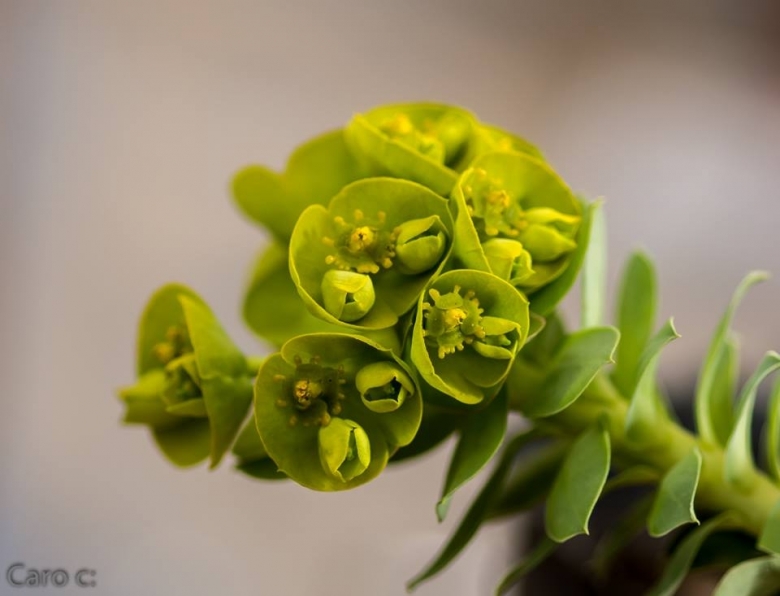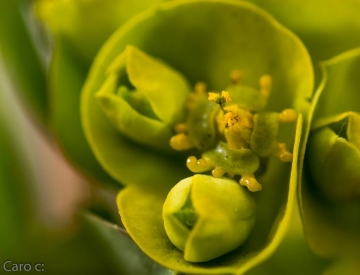Accepted Scientific Name: Euphorbia myrsinites L.
Sp. Pl. 461. 1753. L.

Murtekias myrsinites (Euphorbia myrsinites) Photo by: Carolina González
Origin and Habitat: Euphorbia myrsinitesSN|33182]]SN|33182]] is native to southeastern Europe and Asia Minor, from Italy east through the Balkans to the Crimea and Turkey. It has been distributed into other countries as a greenhouse, garden, and houseplant, and it has escaped from cultivation in North America.
Altitude range: 0-3600 metres above sea level.
Habitat and ecology: This species grows in rocky places, calcareous slopes, mountain pastures and steppes, scrub oak communities and open ground near forests. Euphorbia myrsinitesSN|33182]]SN|33182]] is identified as a noxious weed and/or invasive species in the U.S. states of Colorado, Oregon, Utah.
Synonyms:
See all synonyms of Euphorbia myrsinites
Common Names include:
ENGLISH: Myrtle spurge, creeping spurge, donkey tail, blue spurge, broad-leaved glaucous-spurge
Description: Euphorbia myrsinitesSN|33182]]SN|33182]] (Tithymalus myrsinitesSN|33183]]SN|33183]]) is a greyish-green, tufted, succulent herb, evergreen, perennial, (sometimes biennial). It has dense leafy, sprawling stems growing to 20-40 cm long. The leaves are spirally arranged, fleshy, pale glaucous bluish-green, 1-2 cm long. The flowers are inconspicuous, but surrounded by bright sulphur-yellow bracts. This species is widely cultivated as an ornamental rock-garden plant. The waxy, succulent leaves make Euphorbia myrsinitesSN|33182]]SN|33182]] one of the most drought-tolerant of all hardy garden plants.
Derivation of specific name: The specific epithet myrsinites is derived from the Greek word μυρσινίτης (myrsinites), which was used in Dioscorides's De Materia Medica to describe its similarity to μυρσίνη (myrsine), aka myrtle (Myrtus communis). It often mistakenly refers to another genus Myrsine, whose name is also derived from the Greek name of myrtle.
Stems: Rough, erect or procumbent up to ascendent, solitary or branched, terete, glabrous, 15-40 cm long.
Root: Taproot.
Leaves: Alternate, petiole absent or very short, 1-2 mm, glabrous; blade obovate, obovate-oblong, lanceolate, orbicular or suborbicular, fleshy, 2-30 x 3-17 mm, venation and mid-vein inconspicuous, glabrous, base truncate or attenuate, apex acute to obtuse, cuspidate or strongly mucronate, margin entire or finely denticulate.
Inflorescences (Cyathia): Arising in rays from the axils of the leaves preceding the inflorescence and repeating the pleiochasial ramification. Peduncle 0.5-1 mm long. Terminal rays 2-12, 1-2 times bifurcated. Ray-leaves similar to the upper stem leaves. Subcyathial raylet-leaves free, suborbicular or reniform, base truncate, apex obtuse and mucronulate, margin entire or minutely denticulate. Axillary rays 0-4. Involucre campanulate, 2.4-2.6 long, 2.3-2.5 mm wide, glabrous. Nectar glands 4, crescent-shaped, 1-1.5 mm long, 1.5-2.5 mm wide, horns present (thick with rounded, dilated tips), divergent, 0.5-0.9 mm long. Staminate flowers 6-12. Pistillate flower: ovary glabrous, styles 2.5-2.8 mm, usually umbranched.
Fruit (Capsule): Subglobose, unlobed, smooth, glabrous, 5-7 mm long, 5-6 mm wide; columella 4.5-5 mm long.
Seeds: Ellipsoid, apex and base truncate, arillate, 2.8-4.6 mm long, 2-3.2 mm wide. Surface vermicular-rugose or exceptional smooth, lustre-less, pale-brown to dark-brown or greyish, seldom pale-grey. Plants are capable of projecting seed up to 4.5 metres.
Phenology: Flowering and fruiting spring.
Chromosome number: 2n = 20.
Bibliography: Major references and further lectures
1) Spoerke, Susan C. Smolinske “Toxicity of Houseplants” CRC Press, 03 lug 1990
2) Clive Lane “The Horticulture Gardener's Guides - Plants for Small Spaces” David & Charles, 01 April 2005
3) Vít Bojnanský, Agáta Fargašová “Atlas of Seeds and Fruits of Central and East-European Flora: The Carpathian Mountains Region” Springer Science & Business Media, 17 September 2007
4) “Euphorbia myrsinites” in Euphorbia PBI <http://app.tolkin.org/projects/72/taxa/93130> Web. 5 Oct. 2016.
5) Wikipedia contributors. "Euphorbia myrsinites." Wikipedia, The Free Encyclopedia. Wikipedia, The Free Encyclopedia, 19 Jan. 2016. Web. 5 Oct. 2016.
6) Gledhill, David (2008) “The Names of Plants” (4th ed.). United Kingdom: Cambridge University Press. p. 268.
7) Dioscorides, Pedanius (2000). “De Materia Medica.” South Africa: IBIDIS Press cc. p. 722.
8) "Myrtle Spurge Fact Sheet" (PDF). Salt Lake County Weed Control Program. <http://slco.org/ > Web. 5 Oct. 2013.
9) Huxley, A., “New RHS Dictionary of Gardening.” ed. (1992).
 Murtekias myrsinites (Euphorbia myrsinites) Photo by: Carolina González
Murtekias myrsinites (Euphorbia myrsinites) Photo by: Carolina GonzálezSend a photo of this plant.The gallery now contains thousands of pictures, however it is possible to do even more. We are, of course, seeking photos of species not yet shown in the gallery but not only that, we are also looking for better pictures than those already present.
Read More... Cultivation and Propagation: Euphorbia myrsinitesSN|33182]]SN|33182]] is a precious species for growing in rock-gardens and wall-crowns, it is one of the most drought-tolerant of all hardy garden plants. Grow it in full sun, in gravel, or on top of a retaining wall, to replicate its native Mediterranean rocky habitat. The species can be strongly allelopathic, preventing other plants from growing nearby.
Maintenance: Small infestations can be controlled through multiple years of digging up at least 10 cm of the root. Myrtle spurge is best controlled in the spring when the soil is moist and prior to seed production. Make sure to dispose of all the plant parts in the garbage instead of composting.
Warnings: Its leaves and stems are fairly easily broken to release the irritant latex. The milky sap can cause significant skin and eye irritation in humans. Any amount of this material which contacts the skin, eyes, or mucous membranes has the potential for causing the irritant effects noted Goggles, gloves and protective gear is often used when removing plants. Children are more susceptible than adults to symptoms from myrtle spurge, suggesting play areas not in proximity to the species. Pets can have similar reactions to myrtle spurge sap exposure.
Propagation: Plants spread primarily by seed.











